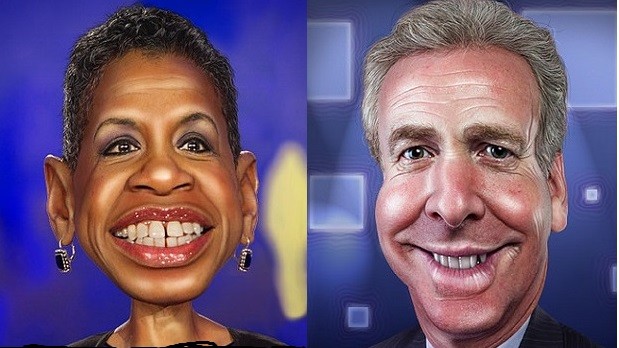By Len Lazarick

Donna Edwards and Chris Van Hollen. Caricatures by DonkeyHotey with Flickr Creative Commons License.
The Democratic primary race to succeed retiring U.S. Sen. Barbara Mikulski is very tight three months before voting begins. In a poll taken last week, Rep. Chris Van Hollen of Montgomery County got 38% of Democratic voters and Rep. Donna Edwards of Prince George’s County got 36%.
This election “looks like it’s going down to the wire,” said pollster Patrick Gonzales, who has been doing political surveys in Maryland for 30 years. “The next three months will be critical,” but ultimately he gives a “slight edge to Edwards.”
Edwards, an African American, does particularly well among African American voters (65%) and in the majority black jurisdictions of Baltimore City (50%) and Prince George’s County, her home base (68%). Van Hollen does well on his home turf, Montgomery County (60%), and the rest of the state (49%). (Full poll results here.)
Presidential race
On the presidential race in both parties, Maryland voters pretty much follow the national trends. For Democrats, it’s Hillary Clinton, 40%; Bernie Sanders, 27%; and Martin O’Malley, 4.5%, with just 18 Democratic voters out of 400 polled supporting the man who governed the state for eight years. For Republicans, it’s Donald Trump, 32% (41% of men, 22% of women); Ted Cruz, 15%; Marco Rubio, 14%; Ben Carson, 9%; Chris Christie, 8%; and Jeb Bush, 4%.
Analyzing the senate race
Gonzales said that “One of the keys to the outcome of this [Senate] contest is how each ultimately performs in their respective geographical base.” He noted that “both counties are part of the Washington suburbs, leaving a large portion of the state up for grabs.”
In a close analysis of the poll number, Gonzales writes:
“This election could well test the old axiom in politics that claims ‘message trumps money,’ because Chris Van Hollen has plenty of money and the proven ability to craft a compelling enough message, as demonstrated by his success 14 years ago, when he took on the ‘Kennedy Dynasty’ in the Democratic primary for Congress in 2002.”
“Donna Edwards would wish to replicate her 2008 effort, when she cobbled together a very impressive coalition of influential, progressive groups and community organizations, which translated into broad success on Election Day.”
“Van Hollen’s recognition and money advantage have propelled him to a 16 point lead in the Baltimore suburbs, and a 2-to-1 lead (49% to 24%) in the Eastern Shore/Southern Maryland and Western Maryland rural parts of the state. But, while the Baltimore suburbs, Eastern Shore/Southern Maryland, and Western Maryland regions comprise 21 of the 23 counties, they make up less than 50% of the vote in a Democratic primary.”
Women favor Edwards slightly
Gonzales sees “a bit of gender partiality in play, with Van Hollen leading among men, 45% to 30%, and Edwards ahead with women, 40% to 33%. Come April this will work to Edwards’ advantage because women make up nearly 60% of the vote in a Democratic primary in Maryland.”
UPDATE, 1/19, 8 a.m.: Reacting to the poll in an email, Van Hollen campaign spokeswoman Bridgett Frey said: “We’re pleased that Chris Van Hollen has maintained his lead, despite the million dollar blitz of Super PAC advertising. We’re confident that voters are looking for his effective, progressive leadership that gets things done for Maryland families.”
The poll was taken Jan. 11-16, contacting 819 registered voters by both landline and cell phone. The margin of error is 3.5%, meaning that there is a 95% probability that the figures would fall within this range if all voters were surveyed.





Amazing that Edwards can be competitive while relying almost solely on out of state super pac money. Proves the entire system is flawed. That should not be allowed.
She’s been outraised 10 to 1 – there’s no monetary advantage for her. Clearly, however, there is an enormous message advantage.
She’s been outraised 10 to 1, but only 3 to 1 when you factor in the million dollars that the super pac has thrown her way.